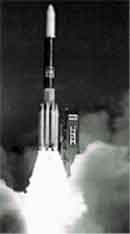Economy launch for satellites
 putting a satellite in space will now become cheaper due to a solar- powered motor being developed in the us. T he motor, called Integrated Solar Upper Stage ( isus ), is being developed jointly by the American Air Force Phillips Laboratory, New Mexico, and nasa's Lewis Research Center and other industrial partners ( New Scientist , Vol 154, No 2087).
putting a satellite in space will now become cheaper due to a solar- powered motor being developed in the us. T he motor, called Integrated Solar Upper Stage ( isus ), is being developed jointly by the American Air Force Phillips Laboratory, New Mexico, and nasa's Lewis Research Center and other industrial partners ( New Scientist , Vol 154, No 2087).
Using isus would mean that a satellite can travel on a smaller booster, slashing the cost by us $300 million . The motor, however, will take 30 days to lift a satellite from low-Earth to geostationary orbit. Liquid-fuelled rockets take about 12 hours for the same task, says Richard Donovan, who will oversee the tests at nasa Lewis Research Centre in Cleveland, Ohio.
At present, three-stage rockets are used to send a satellite in the geostationary orbits. The third stage is a liquid or solid fuelled rocket that boosts the satellite into the correct position before detaching itself. However, isus will stay with the satellite after the correct orbit has been reached, providing power and propulsion throughout the spacecraft's life.
Rigid mirrors attached to the motor direct sunlight into a solar engine that heats liquid hydrogen. The expanded gas is forced through a narrow exhaust pipe, creating thrust to manoeuvre a satellite into position.
Once in orbit, the motor provides power through thermionic converters that turn trapped solar heat into electricity. These metal-coated graphite converters will replace the heavy banks of batteries that power conventional satellites. Preparations for a demonstration of isus by early 2001 are being made.
